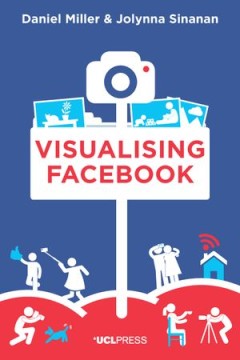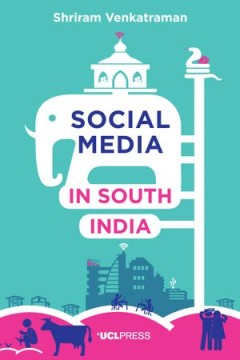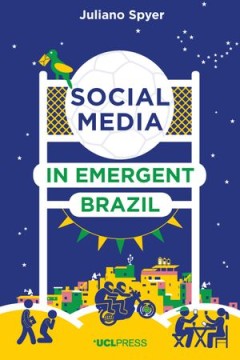Filter by

Visualising Facebook
Since the growth of social media, human communication has become much more visual. This book presents a scholarly analysis of the images people post on a regular basis to Facebook. By including hundreds of examples, readers can see for themselves the differences between postings from a village north of London, and those from a small town in Trinidad. Why do women respond so differently to becom…
- Edition
- -
- ISBN/ISSN
- 9781911307402
- Collation
- -
- Series Title
- -
- Call Number
- -

Visualising Facebook
Since the growth of social media, human communication has become much more visual. This book presents a scholarly analysis of the images people post on a regular basis to Facebook. By including hundreds of examples, readers can see for themselves the differences between postings from a village north of London, and those from a small town in Trinidad. Why do women respond so differently to becom…
- Edition
- -
- ISBN/ISSN
- 9781911307402
- Collation
- -
- Series Title
- -
- Call Number
- -

Social Media in South India
One of the first ethnographic studies to explore use of social media in the everyday lives of people in Tamil Nadu, Social Media in South India provides an understanding of this subject in a region experiencing rapid transformation. The influx of IT companies over the past decade into what was once a space dominated by agriculture has resulted in a complex juxtaposition between an evolving know…
- Edition
- -
- ISBN/ISSN
- 9781911307969
- Collation
- -
- Series Title
- -
- Call Number
- -

Game Production Studies
Video games have entered the cultural mainstream and in terms of economic profits they now rival established entertainment industries such as film or television. As careers in video game development become more common, so do the stories about precarious working conditions and structural inequalities within the industry. Yet, scholars have largely overlooked video game production cultures in fav…
- Edition
- -
- ISBN/ISSN
- 9789048551736
- Collation
- -
- Series Title
- -
- Call Number
- -

From Media Hype to Twitter Storm News Explosions and Their Impact on Issues,…
The word media hype is often used as rhetorical argument to dismiss waves of media attention as overblown, disproportional and exaggerated. But these explosive news waves, as well as - nowadays - the twitter storms, are object of scientific research, because they are an important phenomenon in the public area. Sometimes it is indeed 'much ado about nothing' but in many cases these media storms …
- Edition
- -
- ISBN/ISSN
- -
- Collation
- -
- Series Title
- -
- Call Number
- -

Social Media in South India
One of the first ethnographic studies to explore use of social media in the everyday lives of people in Tamil Nadu, Social Media in South India provides an understanding of this subject in a region experiencing rapid transformation. The influx of IT companies over the past decade into what was once a space dominated by agriculture has resulted in a complex juxtaposition between an evolving know…
- Edition
- -
- ISBN/ISSN
- 9781911307969
- Collation
- -
- Series Title
- -
- Call Number
- 302.23 VEN s

Social Media in Emergent Brazil
Since the popularisation of the internet, low-income Brazilians have received little government support to help them access it. In response, they have largely self-financed their digital migration. Internet cafés became prosperous businesses in working-class neighbourhoods and rural settlements, and, more recently, families have aspired to buy their own home computer with hire purchase agreeme…
- Edition
- -
- ISBN/ISSN
- 9781787351653
- Collation
- -
- Series Title
- -
- Call Number
- 302.23 SPY s

Regulating Content on Social Media
How are users influenced by social media platforms when they generate content, and does this influence affect users’ compliance with copyright laws? These are pressing questions in today’s internet age, and Regulating Content on Social Media answers them by analysing how the behaviours of social media users are regulated from a copyright perspective. Corinne Tan, an internet governance spec…
- Edition
- -
- ISBN/ISSN
- 9781787351714
- Collation
- -
- Series Title
- -
- Call Number
- 658.81 TAN r

Public Broadcasting in Africa Series: Uganda
Uganda’s broadcast media landscape has witnessed tremendous growth in recent years. While the public broadcaster remains the dominant national player – in terms of reach – in both radio and television, commercial broadcasters have introduced a substantial level of diversity in the industry. Public broadcasting faces serious competition from the numerous private and independent broadcaster…
- Edition
- -
- ISBN/ISSN
- 9781920489717
- Collation
- -
- Series Title
- -
- Call Number
- 302.23 LUG p

Public Broadcasting in Africa Series: Zimbabwe
This report is the result of research that started in 2008 with the aim of collecting, collating and writing up information about regulation, ownership, access, performance as well as prospects for public broadcasting reform in Africa. The Zimbabwe report is part of an 11-country survey of African broadcast media, evaluating compliance with the agreements, conventions, charters and declarations…
- Edition
- -
- ISBN/ISSN
- 9781920489687
- Collation
- -
- Series Title
- -
- Call Number
- 302.23 CHI p
 Computer Science, Information & General Works
Computer Science, Information & General Works  Philosophy & Psychology
Philosophy & Psychology  Religion
Religion  Social Sciences
Social Sciences  Language
Language  Pure Science
Pure Science  Applied Sciences
Applied Sciences  Art & Recreation
Art & Recreation  Literature
Literature  History & Geography
History & Geography